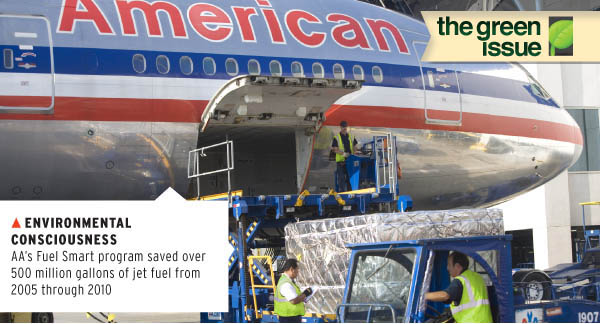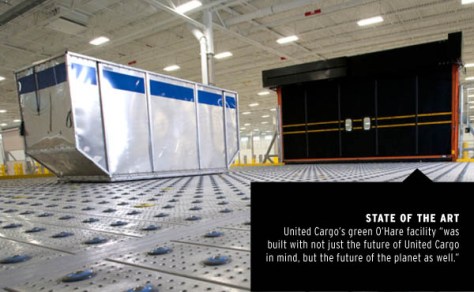AIR CONDITIONER
DRIVEN BY SAVINGS AND SUSTAINABILITY, AIR CARRIERS LIKE AMERICAN AIRLINES ARE CLEANING UP THE CARGO BUSINESS
At 35,000 feet, it doesn’t take an environmentalist to see that the planet could benefit from emissions reductions. American Airlines is leading the effort with programs like the Fuel Smart program, which saved over 500 million gallons of jet fuel from its inception in 2005 through 2010. “While many of our customers are interested in American’s sustainability efforts,” notes Joe Reedy, VP of cargo sales and marketing at American Airlines, “our initiatives are driven from the perspective of corporate environmental responsibility.”
That sense of responsibility is earning AA recognition. Named the greenest air carrier in Newsweek’s annual Green Rankings for two years running, AA also claimed the magazine’s No. 49 spot for greenest overall in its 500 most environmentally responsible publicly traded companies in the U.S., and the most responsible company in transportation and logistics.
“Environmental consciousness is a growing trend across many kinds of industries today,” notes Tristan Koch, the airline’s director of cargo sales for Europe, Middle East and Africa. AA Cargo has long recognized the connection between their shippers’ bottom lines, its own financial success, and the planet’s overall health.
The airline industry collectively contributes only about two percent of the world’s buildup of manmade CO2 emissions (according to the United Nations Intergovernmental Panel on Climate Change), though many in the industry believe two percent is too much.
The overwhelming majority of airlines’ greenhouse gas (GHG) emissions—about 98 percent—is connected to the consumption of jet fuel. AA’s Fuel Smart program is only one way they are striving to reduce their environmental impact. As Koch notes, fuel consumption is intimately connected to aircraft weight. “Removing 100 pounds from each plane means over 1.1 million gallons saved annually,” says Koch.
One important step in trimming the weight in American’s Cargo division is its composite container initiative. In 2011, AA Cargo began to replace its aluminum LD3 containers with fiberglass composites. Each new LD3 is nearly 66 pounds lighter than the aluminum container it replaced.
With a fleet of over 900 aircraft, small improvements on each plane can mean huge reductions in GHG emissions. For example AA has added “winglets” (wingtip extensions) to some of the planes in its fleet. Perhaps misnamed, the nearly one-story tall winglets smooth out the airflow at the ends of the wings, reducing drag at cruising altitude. In 2010, these extensions saved 35 million gallons of fuel and eliminated nearly 750 million pounds of CO2 emissions.
The most exciting initiative is AA’s search for alternative fuels. One possible source is Solena Fuels, a California-based company developing jet fuel made from post-cycled urban and agricultural waste. Their “Green Sky California” initiative is expected to produce up to 15 million gallons of aviation fuel per year starting in 2015. This fuel not only emits lower GHG than any petroleum-based fuel, it will also keep 550,000 metric tons of waste out of landfills.
American Airlines is also exploring renewable fuel derived from camelina, a member of the mustard family that grows on marginal land, requires little water, and produces pods teeming with small, oily seeds. A study conducted at Michigan Tech University for Bozeman, Montana-based Sustainable Oils showed that renewable jet fuel made from camelina is molecularly indistinguishable from the petroleum-based product, yet reduces carbon emissions by 84 percent. If scaled up as planned, camelina growers could soon be producing hundreds of millions of gallons of jet fuel annually.
American Airlines isn’t flying alone in its commitment to environmental responsibility. Among others, United Continental Holdings stands out for its rounded approach. In November 2011 their United subsidiary operated the first U.S. commercial flight powered by a blend of algae-derived biofuel and traditional petroleum jet fuel. The way forward looks promising as United works with alternative fuel producers, the U.S. government and military to advance the viability of biofuel for commercial use.
To reach their sustainability goals, United maintains an Environmental Management System (EMS) that supports, monitors and coordinates their activities to comply with local, state and federal environmental regulations. Their team of environmental experts conducts formal compliance assessments to audit environmental performance, recommend corrective actions, manage impact reduction projects and provide ongoing training and guidance.
In February, United Cargo inaugurated its state-of-the-art green facility at Chicago’s O’Hare Airport. The new facility’s environmental friendliness starts on top with one of the nation’s largest vegetative living roofs, and extends down to the parking lot and surrounding areas with the use permeable pavers to reduce storm water pollution. The warehouse is also outfitted with many recycled fixtures and components.
“It’s gratifying that our new warehouse was built and is operated with not just the future of United Cargo in mind, but the future of the planet as well,” says Rod Zimmerman, United’s senior manager of cargo operations at O’Hare. “Our new warehouse is an important tool in our drive to achieve even higher levels of operational and customer service excellence,” Zimmerman adds.
O’Hare is a good location for a green facility, and serves as the best example of airports working toward sustainability. The Chicago Department of Aviation (CDA) is determined to develop the green airport of tomorrow today, through its O’Hare Modernization Program (OMP). “Our goal is to complement and promote the City of Chicago’s commitment to green initiatives and to enhance the quality of life for our citizens,” writes Rosemarie S. Andolino, the commissioner of the CDA in her introduction to the OMP’s Sustainable Airport Manual (SAM). The OMP, she says, “established the model for green airport development.”
The OMP focuses resources on sustainable practices that reduce the environmental impact of development. For instance, the CDA requires contractors to use the most efficient construction equipment available; has kept 6.3 million cubic yards of earthwork on site and out of landfills (that’s twice the volume of the concrete in Hoover Dam); and ensures that construction waste generated by the OMP is used on other OMP projects or sorted to maximize recovery of materials. The CDA, working with federal and state agencies, has created or restored nearly 450 acres of high quality, publicly accessible wetland and associated nature areas to mitigate the effects of OMP construction. And in 2011, the CDA installed an apiary of 33 beehives at O’Hare, with over 1.3 million bees. Made possible through a job training partnership with the City’s Department of Family Support Services, it is the largest apiary at any airport in the world.
Another intriguing project in the OMP is the installation of vegetated roofs on airport buildings, like United Cargo’s. The roof atop the new FedEx Cargo Facility at O’Hare measures nearly 175,000 square feet—the largest freestanding green roof in the central United States. According to the CDA’s 2011 Sustainability Report, green roofs reduce the “heat island” effect; improve insulation and reduce the need for air conditioning; increase storm water retention and decrease the need to expand drainage infrastructure (the FedEx roof alone is estimated to retain two million gallons of water annually); and absorbs dust and greenhouse gases—in fact, each square meter of vegetated roof removes about four-and-a-half pounds of airborne particulates each year. In addition, vegetated roofs extend the life of roof by 15 to 20 years.
The installation of the FedEx roof was a special challenge due to the presence of active runways within 200 yards and active airspace on three sides of the building. But with a coordinated effort, the installation was completed in 17 days. The plant species on the roofs were chosen for their tolerance for drought, low maintenance requirements, and lack of food production—which reduces its attractiveness to birds, a no-brainer for an airport. But the presence of the roof can be seen by millions of visitors flying to and from O’Hare every year, providing an educational opportunity and crystallizing the CDA’s commitment to the environment.
For shippers seeking carriers who promote green values and goals, the timing has never been better. “We have installed vegetated roofs, saved energy, reduced air emissions, and conserved water and other natural resources,” writes the CDA’s Andolino. “I am proud of our efforts and accomplishments to date. However, I know that together we can do even more.”
AT MIQ LOGISTICS, GREEN SAVES GREEN
MIQ Logistics’ entire 3PL business is built around improving the efficiency of customers’ supply chains, and not coincidentally finding a greener way to do business.
“Shippers ask us what opportunities there are to become involved in green initiatives,” says Steve Woody, the director of MIQ’s Solutions Design Group. “They ask how we can help them perform more efficiently.”
A charter member of the U.S. EPA’s SmartWay Transport Partnership, MIQ received the Environmental Excellence Award for its efforts to help clients reduce greenhouse gas emissions. “We use the SmartWay Profile to assist our customers with carrier selection, in an effort to help them recognize opportunities to reduce these emissions,” explains MIQ’s Woody. “A smaller carbon footprint can be identified.”
MIQ starts with the EPA’s Shipper Fleet Performance Model, which helps shippers estimate greenhouse gas (GHG) emissions by road and rail, and expands the model to include air carriers and ships at sea. With this model, MIQ helps clients fine-tune their transportation strategies to determine routes or modes of transportation that reduce emissions.
In addition to keeping a careful eye on emissions, MIQ introduced many other environmentally kinder innovations, such as adding reusable totes for use in chemical shipments. These reusable containers eliminate the need to manufacture and dispose of steel drums. Currently MIQ is evaluating hydrogen cell battery forklifts as part of their material handling equipment options. “These may project higher costs up front, but spread over time, they can be as cost effective as traditional powered equipment,” says Woody. Improving efficiency reduces costs overall, and green benefits follow, so there isn’t a trade-off between the financial side of a shipper’s business and their green initiatives.






Leave a Reply